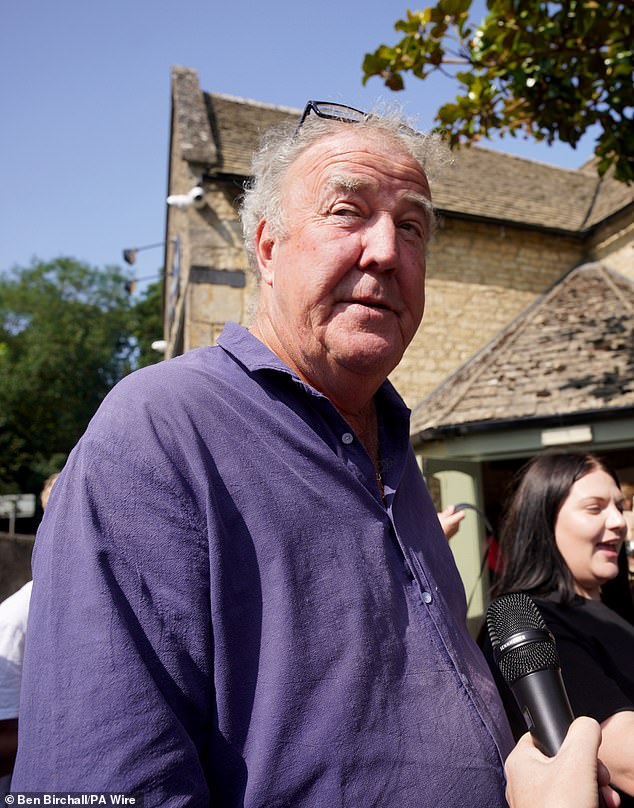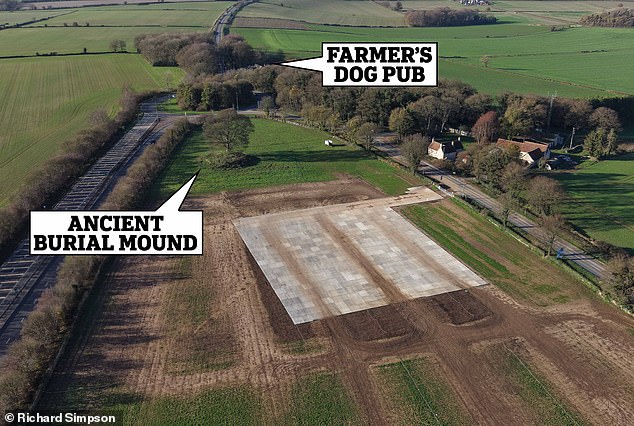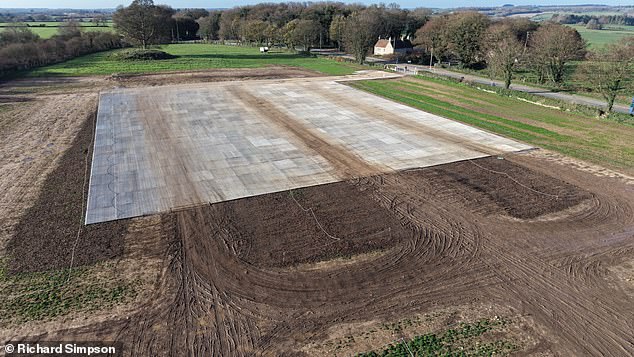Glinting brightly in the sunlight and so large it is even visible from space, this is the new 100,000 sq ft reinforced metal car park surface Jeremy Clarkson has installed at his Oxfordshire pub The Farmer’s Dog.
The colossal structure plastered across a once pretty green hilltop field in the Cotswolds Area of Outstanding Natural Beauty is made up of 530 inch-thick strengthened aluminium sheets measuring 15ft x 12ft linked together to form a hard surface for cars in the pub’s six-acre overflow car park.
Clarkson has been forced to install the huge cover to protect important archaeological remains which have been located beneath the car park and which are linked to a listed 1,400-year-old burial mound containing the remains of a Viking warlord just a few feet away.
A geophysical survey beneath the ground was triggered this summer when Clarkson applied for retrospective planning permission to use the field as an overflow car park, despite him using it for that exact purpose for the past year already.
A specialist archaeological team found significant remains possibly linked to the nearby burial mound under the car park itself.
The metal covering, which weighs hundreds of tonnes, cost Clarkson an eye watering sum to hire, and comes after he has detailed how tough it is making money at the pub, despite being fully-booked since it opened in 2024.
The full size of the metal covering is clear from these exclusive aerial photos taken earlier this week.
The retrospective planning application is yet to be decided and the car park may well close completely, which would be disastrous for the The Farmer’s Dog which depends almost entirely on driving punters.

Clarkson has been forced to install the huge metal cover to protect important archaeological remains which have been located beneath the pub’s overflow car park

A geophysical survey beneath the ground was triggered this summer when Clarkson applied for retrospective planning permission to use the field as an overflow car park

The Farmer’s Dog in Asthall (pictured) has been a huge hit with fans, but it’s not been quite as popular with locals
Locals have complained about the application saying Clarkson only wants planning for 360 cars, although they say they have spotted 1,000 parked there at a time in the past year.
A specialist archaeological report by John Moore Heritage Services accompanying the application described potential problems with having such a busy car park right next to the Asthall Barrow burial mound.
The report said the car park was “located immediately adjacent to Asthall Barrow, one of the best-preserved examples of an Anglo-Saxon burial mound in Oxfordshire.
As a Scheduled Monument the barrow is recognised as being of national importance, largely due to its archaeological interest.
The report also said the car park would have a ‘visual impact’ and also ‘an impact on archaeological remains within the setting of the monument’ which had yet to be retrieved.
A report by Historic England accompanying the application said: ‘The Asthall Barrow is special because it represents a particularly rare class of monument, with only around 50-60 examples known nationally.
‘These burial mounds, or hlaews, were constructed during the Anglo-Saxon or Viking periods for individuals of high rank, serving as highly visible and ostentatious markers of social position. Some were associated with territorial claims and appear to have been specifically located.’
The report went on: ‘We understand the car park does not extend to within the Scheduled Monument.

Locals have complained about the application saying Clarkson only wants planning for 360 cars, although they say they have spotted 1,000 parked there at a time in the past year

A specialist archaeological team found significant remains possibly linked to the nearby burial mound under the pub’s car park itself

Near to the boozer, just yards away, is an ancient 7th century burial mound, called Asthall Barrow (pictured)
‘However, the applicant should take steps to avoid the risk of damage, by vehicles encroaching on the monument, and should also be aware that if any associated works (e.g. fencing, landscaping, tipping, etc) are to occur on or within the monument boundary, this would require permission from the Secretary of State for Culture, Media and Sport, in the form of Scheduled Monument Consent.’
An Asthall Parish Council letter attached to the application also made the suggestion to install a ‘membrane’ covering the car park to prevent further damage to whatever might be underneath the field.
The council suggested a grassed surface reinforced with a mesh. They added an educational ‘interpretation board’ within the proposal site or along the pedestrian route to The Farmer’s Dog that would ‘allow a much greater number of people than previously possible to appreciate the significance of the monument’.
The council also raised concerns about; mud on the road; confusing signage potentially causing accidents; concerns about the car park entrance being close to a blind bend; concerns about the safety of pedestrians.
Clarkson spent £1m to take charge of The Farmer’s Dog last summer. Its chaotic opening featured in the last series of the hugely popular Amazon Prime Video show Clarkson’s Farm.
As soon as Clarkson acquired the pub lease he knew he needed to increase its parking capacity – because of what happened previously when he opened his hugely popular Diddly Squat Farm Shop near Chadlington.
Fans came in their hundreds to the farm shop causing traffic jams with punters parked for miles around on the grass verges of narrow single-tracks, blocking roads and causing fury among neighbours.
Clarkson quickly struck a deal just days before the Farmer’s Dog opened with local landowners Edward and Patricia Walker to lease the field with motorists charged £2 to park there, £1 of which would go to the Walkers.
The arrangement seemed to be going well with cars flooding in and out since last summer’s August opening, all carefully managed by parking wardens wearing hi-vis jackets, as Clarkson’s pub tills rang day and night.
But there were then calls to stop using the field because it was so close to the burial mound.
Asthall Barrow, which dates from the seventh century AD, contains the cremated remains of a ‘high-status individual’, probably a Viking or Anglo Saxon warlord commanding all or part of one of the regional kingdoms the country was divided into during the Dark Ages.
The barrow is listed and protected by Historic England in the heritage category of a ‘scheduled monument’ in the same way that Stonehenge is.
